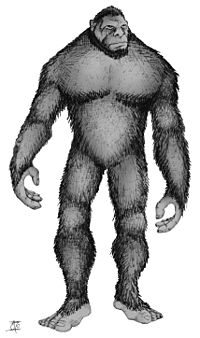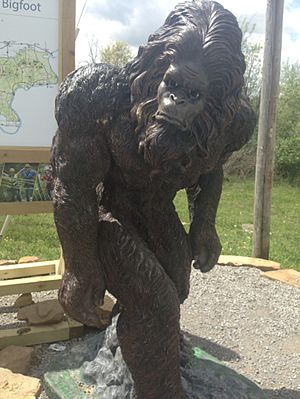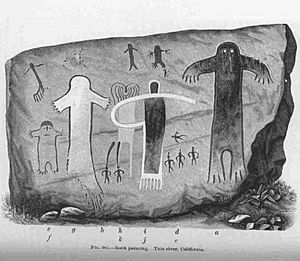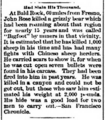Bigfoot facts for kids
| Sasquatch | |
|---|---|
Quick facts for kids  |
|
| An artist's depiction of Bigfoot. | |
| Creature | |
| Name: | Sasquatch |
| AKA: | Bigfoot |
| Classification | |
| Grouping: | Cryptid |
| Data | |
| First reported: | In folklore |
| Country: | United States, Canada |
| Region: | California |
| Habitat: | Forests, Swamps, Mountains |
Bigfoot, also known as Sasquatch, is a mysterious, ape-like creature. Many people say they have seen it in the forests of North America. It is especially reported in the Pacific Northwest. Even though many people claim to have seen Bigfoot or its tracks, no one has ever captured one. No one has found a dead Bigfoot either. Because of this, some people do not believe Bigfoot is real.
Some scary stories say Bigfoot is a dangerous monster. However, most people who study Bigfoot think it is probably gentle and smart, much like humans. Bigfoot is said to be very tall, usually 7 to 9 feet (about 2 to 2.75 meters) tall. It is covered in brown, black, red, or sometimes even white fur or hair. Its feet are said to be very big, about 13 inches long (0.3 meters). This is why it is called Bigfoot!
Bigfoot is mostly seen in the forests of the Pacific Northwest. But sometimes people report seeing it in the Great Lakes area or the Midwest. It has even been reported in swamps in the Southern United States. Some people think Bigfoot might be related to the Yeti of the Himalayas. The name Sasquatch comes from the Halkomelem language. This language is spoken by some First Nations groups in south-western British Columbia.
Contents
What Does Bigfoot Look Like?
Bigfoot is often described as a large, strong creature. It looks like an ape or a human. It is covered in black, dark brown, or dark reddish hair. Some people say the creature can stand as tall as 10 to 15 feet (3 to 4.5 meters).
Other common descriptions include wide shoulders and no visible neck. It is also said to have long arms. The huge footprints that give the creature its name can be as large as 24 inches (61 cm) long and 8 inches (20 cm) wide.
Bigfoot Stories from the Past
Ancient Stories and Early Reports
Many native cultures across North America have tales of mysterious, hairy forest creatures. These legends existed long before modern Bigfoot reports. The stories changed depending on the region and even between families. They are very common in the Pacific Northwest.
At the Tule River Indian Reservation, there are petroglyphs (rock carvings) at a place called Painted Rock. Some people believe these carvings show a group of Bigfoot called "the Family." The local tribes call the largest carving "Hairy Man." These carvings are thought to be 500 to 1000 years old.
In the 16th century, Spanish explorers and Mexican settlers told stories of los Vigilantes Oscuros. This means "Dark Watchers." They were large creatures said to stalk their camps at night. In 1721, a Jesuit priest lived with the Natchez in what is now Mississippi. He reported stories of hairy forest creatures that screamed loudly and stole farm animals.
The Sts'ailes people tell stories about sasq'ets. This is a shapeshifting creature that protects the forest. The name "Sasquatch" is the English version of sasq'ets. It roughly means "hairy man" in the Halq'emeylem language.
The Lummi people tell tales about creatures called Ts'emekwes. These stories are similar in how they describe Ts'emekwes. But details about what the creature ate or did changed among different family accounts. Some local stories tell of more threatening creatures. The stiyaha or kwi-kwiyai were night creatures. Children were warned not to say their names so the "monsters" would not come and take them away.
The Iroquois tell of a giant, hairy creature with rock-hard skin. It was known as the Ot ne yar heh or "Stone Giant." It is more commonly called the Genoskwa. In 1847, Paul Kane heard stories from natives about skoocooms. These were wild men living on the peak of Mount St. Helens.
U.S. President Theodore Roosevelt wrote about a story in his 1893 book, The Wilderness Hunter. An old mountain man named Bauman told him about a foul-smelling, two-legged creature. It had ransacked his beaver trapping camp. Roosevelt noted that Bauman seemed scared telling the story.
A version by Reverend Elkanah Walker mentions stories of giants. These stories came from natives living near Spokane, Washington. These giants were said to live on nearby mountain peaks. They would steal salmon from fishermen's nets.
How Bigfoot Got Its Name
In 1958, Jerry Crew was a bulldozer operator for a logging company. He was working in Humboldt County, California. He found a set of large, 16-inch (41 cm) human-like footprints deep in the mud. This was in the Six Rivers National Forest. He told his coworkers, and many said they had seen similar tracks before. They also told of strange things happening. For example, an oil drum weighing 450 pounds (204 kg) had been moved without explanation.
The logging workers soon started calling the unknown culprit "Bigfoot." Crew first thought someone was playing a trick on them. After seeing more of these huge footprints, he contacted reporter Andrew Genzoli. Genzoli worked for the Humboldt Times newspaper. Genzoli interviewed the lumber workers. He wrote articles about the mysterious footprints. He used the name "Bigfoot" for the tracks and the local tales of large, hairy wild men.
A plaster cast was made of the footprints. Crew appeared on the front page of the newspaper on October 6, 1958, holding one of the casts. The story quickly spread. Genzoli started getting messages from big news groups like the New York Times and Los Angeles Times. Because of this, the name Bigfoot became widely known. It referred to a large, unknown creature leaving huge footprints in Northern California. As a result, Willow Creek and Humboldt County are sometimes called the "Bigfoot Capital of the World."
Other Names for Bigfoot

Many regions have different names for these creatures. In Canada, the name Sasquatch is widely used. It is often used along with the name Bigfoot. The United States uses both of these names. But it also has many other names and descriptions. These depend on the region where the creatures are supposedly seen.
Some of these names include the Skunk ape in Florida and other southern states. There is the Grassman in Ohio. The Fouke Monster is in Arkansas. The Wood Booger is in Virginia. The Monster of Whitehall is in Whitehall, New York. Momo is in Missouri. The Honey Island Swamp Monster is in Louisiana. The Dewey Lake Monster is in Michigan. The Mogollon Monster is in Arizona. The Big Muddy Monster is in southern Illinois. And The Old Men of the Mountain are in West Virginia.
Some people use the term Wood Ape. They use it to avoid the idea that "Bigfoot" is just a myth. Other names include Bushman, Treeman, and Wildman.
Pictures and Movies of Bigfoot
Sometimes, people who see a Bigfoot take a picture or a movie of it. The most famous of these is the "Patterson-Gimlin movie." It is named after the men who took the movie, Patterson and Gimlin. In the movie, a large, ape-like creature walks from a lake into a forest.
This is the best movie so far of a creature that might be Bigfoot. Because of this, scientists argue about it a lot. Some think the creature is a real Bigfoot. Others think it is just a person in a gorilla costume. People have done experiments with men in gorilla costumes. They try to move like the creature in the movie. So far, no one has been able to move exactly like it.
This is why there are many Bigfoot hoaxes (fake sightings). Bigfoot can also be mistaken for a grizzly bear. The evidence from the movie is surprising. But many people have questioned it. Some experts believe if the movie is played slightly faster, it could have been a man wearing a rubber costume. However, parts of the footage are amazing. For example, scientists who study how living things work say that for Bigfoot to walk upright, it would need a special extended heel. The creature in the movie also has an extended heel.
Images for kids
-
A 2007 photograph of the Bigfoot trap in the Rogue River–Siskiyou National Forest.
-
A funny sign warning of Bigfoot crossings on Pikes Peak Highway in Colorado.
See also
 In Spanish: Pie Grande para niños
In Spanish: Pie Grande para niños









